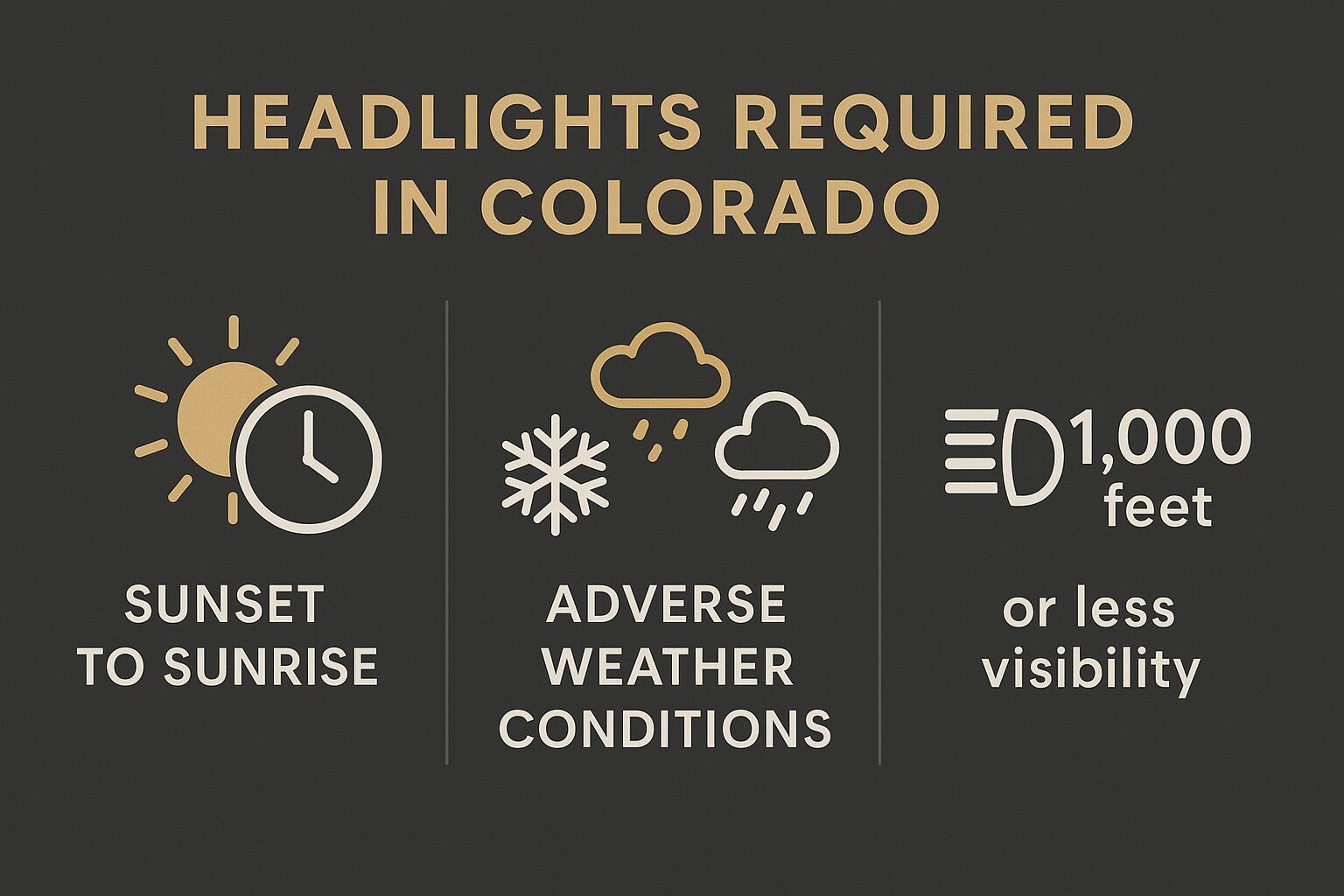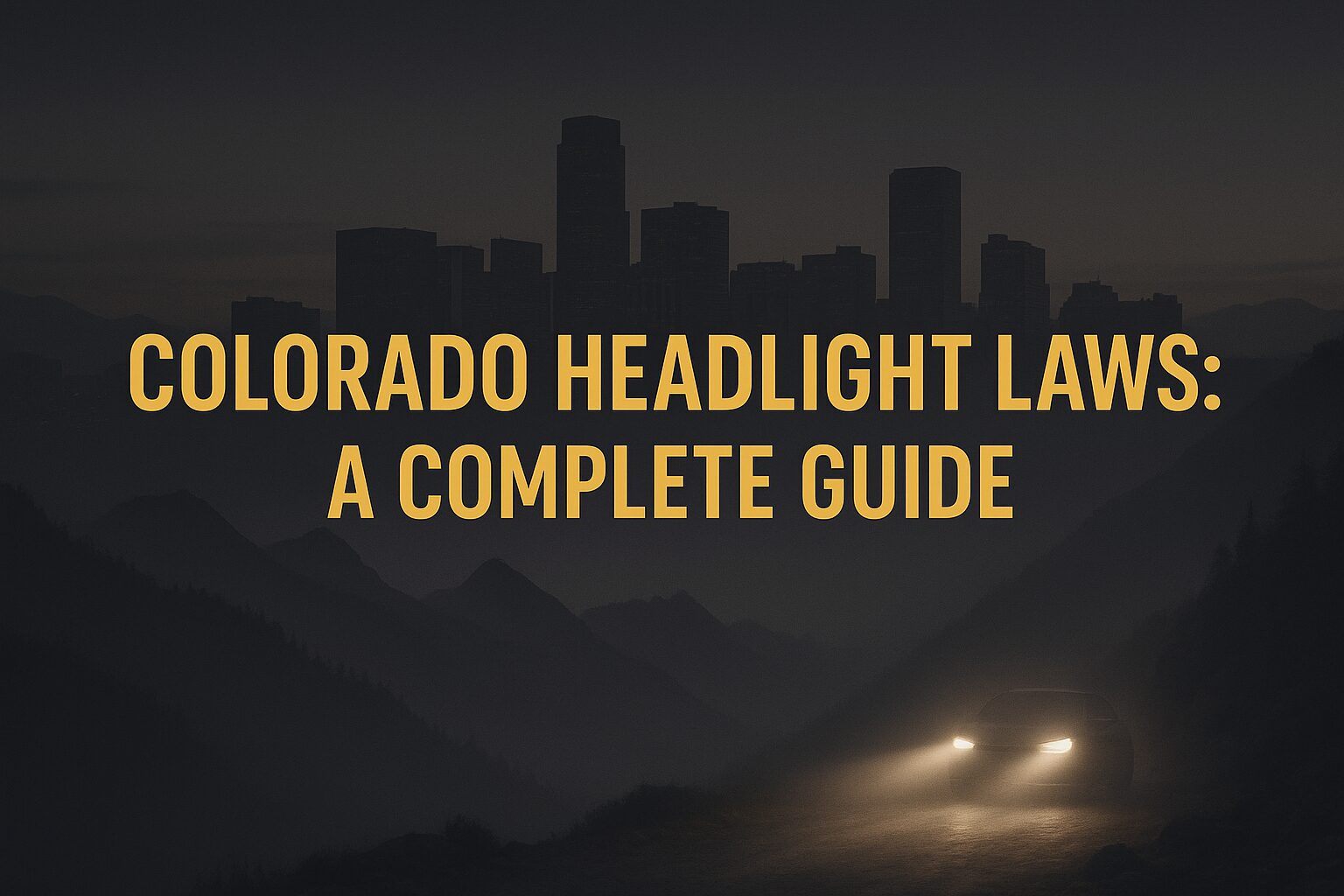TL;DR: Key Points About Colorado Headlight Laws
- Headlights must be used from sunset to sunrise and during adverse weather or poor visibility conditions (less than 1,000 feet).
- High beams must be dimmed when approaching an oncoming vehicle within 500 feet or following another vehicle within 200 feet.
- Vehicles must have at least two functioning headlights emitting white or amber light; certain colors like green or blue are illegal.
- LED headlights are legal in Colorado if they comply with brightness and color regulations.
- Driving without headlights when required is a Class A traffic infraction, resulting in fines and points on the driver’s license.
- Violating headlight laws can be considered negligence per se and may impact liability in car accident claims.
- Auxiliary passing lamps, fog lights, and other auxiliary driving lamps supplement but do not replace headlights.
- Proper headlight use is critical for safety in Colorado’s frequent low visibility and adverse weather conditions.
- Consult a Colorado car accident attorney if injured due to someone else’s negligent headlight use.
Colorado law requires headlights from sunset to sunrise and during any weather that reduces visibility. This isn’t just about seeing the road—it’s about making sure other drivers see you.
Headlights signal your presence to others, which matters in a state where fog, snow, and heavy rain are common. They’re critical safety features during dusk, dawn, and poor weather conditions.
Colorado links headlight requirements to other safety rules to protect everyone on the road.
Driving without working headlights is illegal in Colorado. Given the state’s rugged terrain and limited street lighting in many areas, Colorado enforces strict headlight laws.
When headlight violations cause crashes, our Denver car accident attorneys help injured drivers prove the other party’s negligence and recover damages.
Colorado vehicle lighting laws include:
- Headlights must be used from half an hour after sunset to half an hour before sunrise, and at any other time when visibility is reduced to less than 1,000 feet. This includes rain, snow, fog, and smoke from wildfires, which are not uncommon in Colorado (C.R.S. § 42-4-204).
- The lights must be bright enough to illuminate objects at a distance of at least 350 feet ahead for high beams and 100 feet ahead for low beams. The intensity should not be so high as to cause glare to other drivers (C.R.S. § 42-4-216o)). How bright headlights should be is determined by legal standards to ensure safety and avoid causing glare or a traffic infraction.
- They must be adjusted so that the high beams do not project into the eyes of oncoming drivers. When approaching another vehicle within 500 feet or following within 200 feet, drivers must switch to low beams to avoid blinding other drivers. Bright headlights must comply with Colorado’s headlight laws and the state’s headlight laws, and drivers are required to dim high beams when approaching an oncoming vehicle or when there is a vehicle ahead within a certain distance.
- All motorcycles’ headlamps must be on at all times (even during the day) when the motorcycle is being operated to increase visibility and safety.
- Headlights must emit white or amber light. This applies to both the main headlights and any auxiliary front lights. Taillights must be red. Rear turn signals can be either red or amber. Colors such as blue, green, or any other colors that might be confused with emergency vehicles are not permitted for headlights or other exterior vehicle lights.
- Vehicles must have at least two functioning headlights, one on each side of the front of the vehicle.
- Vehicles are subject to inspections that include checks on the proper functioning and alignment of headlights.
All standard motor vehicles and other types of motor vehicles must be equipped with the required lighting equipment and illuminating devices as specified by Colorado headlight law.
Driving without headlights when required is considered a Class A traffic infraction in Colorado. If someone is caught violating any of these Colorado headlight regulations, they have to face:
- A monetary fine ranging from $15 to $100, depending on the municipality and whether it is a first or repeated offense.
- 2 points to the driver’s license. Accumulating too many points (12 points for adult drivers in any consecutive 12-month period; 9 points for minor drivers) can lead to license suspension.
Certain violations, such as failing to use headlights or improper adjustment, can result in a class b traffic infraction or class b traffic penalty, which is a type of traffic violation and one of several possible traffic infractions under Colorado law.
Headlights must be used not only during adverse weather but also during periods of normal sunlight when poor visibility may occur. Obeying Colorado’s headlight laws is essential for safety and legal compliance.
Types of Headlights on Cars and Motorcycles in Colorado
Some of the most common types of headlights on motor vehicles in Colorado are:
- Halogen Headlights: These are relatively inexpensive, with a lifespan of about 450 to 1,000 hours.
- Xenon HID (High-Intensity Discharge) Headlights: These create a much brighter, whiter/bluish light than halogen bulbs.
- LED (Light Emitting Diode) Headlights: These last up to 20,000 hours and have an in-built cooling system to handle the heat generated to convert electricity into light. LED headlights must comply with Colorado state regulations regarding color and brightness to ensure legality and road safety.
- Laser Headlights: Laser lights are the newest model on the market, with the ability to illuminate the road up to 600 meters ahead.
Staying Safe in Bad Weather: Headlight Use Tips
Driving in Colorado’s unpredictable weather—whether it’s dense fog, heavy rain, or blowing snow—means facing limited visibility and increased risks on the road. To protect yourself and others, it’s essential to use your vehicle’s lighting equipment correctly and in accordance with Colorado headlight laws.
When visibility drops below 1,000 feet due to adverse weather conditions, headlights must be used, even during daylight hours. Rely on low beams rather than high beams in fog, snow, or rain, as high beams can reflect off moisture in the air and actually make it harder to see. Using low beams helps you avoid blinding oncoming vehicles and drivers ahead, reducing the risk of car accidents.
Fog lights and auxiliary driving lamps can provide better visibility in certain conditions, but remember that these are meant to supplement—not replace—your standard headlights. Always ensure your headlights are functioning properly; broken or faulty headlights can leave you with insufficient light and make your vehicle nearly invisible to other drivers.
Colorado law also restricts the use of certain headlight colors and intensities. Avoid custom headlights, excessively bright LED lights, blue lights, or green lights, as these can distract or impair the vision of other drivers and may result in a traffic infraction. Stick to approved headlight colors—white or amber—for both your main headlights and any auxiliary lighting.
How Violating Headlight Laws May Impact Your Car Accident Claim in Colorado
Driving without headlights when they are required is considered a breach of the duty of care expected from a driver. Headlights are necessary for both seeing and being seen by other drivers. If a driver fails to use them appropriately, they are not meeting the standard of care required, which is to ensure their vehicle is visible to others and that they have adequate visibility of the road. Violating headlight laws can result in fines and points being added to the driver’s license, which may impact insurance rates and driving privileges.
This is known as negligence per se; it occurs when a person violates a statute or regulation and causes harm that the law was designed to prevent. If a driver did not turn on their headlights when they should have, and this resulted in your car accident injuries, their “negligence per se” means you do not have to prove that the driver was negligent in the usual sense, only that the Colorado vehicle lighting law was violated and this caused the accident. A driver’s negligent failure to use headlights as required can make them liable for damages in a personal injury case, including responsibility for victims’ medical bills.
However, Colorado follows a modified comparative negligence rule, so if you are found partially responsible for the crash, your compensation will be reduced accordingly. If you are found to be 50% or more at fault, you cannot recover any damages. If a car accident is caused by someone else’s negligent headlight use or else’s negligent headlight, the at-fault party may be held responsible for all resulting damages.
Consult with a skilled Colorado car accident attorney as soon as possible to obtain compensation for your injuries, medical expenses, lost wages, pain and suffering, and more. Remember, insurance companies will consider the headlight law violation as a strong factor in determining fault, so you need robust legal representation to fight for your rights.
Our Colorado Auto Accident Lawyers Can Maximize Your Compensation
At Fuller Personal Injury Law, we represent the victims of car accidents, truck crashes, motorcycle collisions, and pedestrian accidents, and help them achieve the best possible outcome through relentless, evidence-based negotiations with the insurance companies as well as aggressive litigation in court (if the case goes to trial). Over the last 22 years, we have recovered more than $50 million for our clients in Colorado.
The moment you sign up with us, our experienced Colorado car accident lawyers will move fast to collect the following evidence to establish the negligence of the other driver and help you obtain the compensation you need to rebuild your life.
- Photographs and videos of the crash site, vehicle positions, skid marks, and damaged/lack of headlamps
- Surveillance footage from your vehicle’s dash cam, nearby businesses, and traffic lights
- Witness statements
- Police reports (to note the headlight violation, any citations issued, and the officer’s observations)
- Other driver’s cell phone records (to determine if they were texting or calling at the time)
- Vehicle inspection reports (showing the state of the headlights)
- Testimonies from accident reconstruction experts, automotive lighting experts, traffic safety engineers, and medical experts
- Local weather and lighting condition reports for the time of the accident
- Your medical records
Call us at (720)770-3832 or fill out this contact form to schedule your free case review with our legal team. We offer a free consultation to discuss the details of your case and your legal options.












